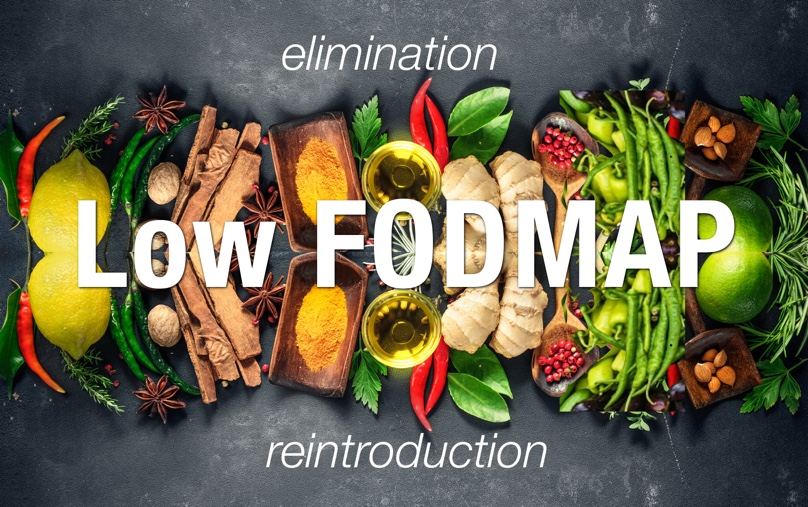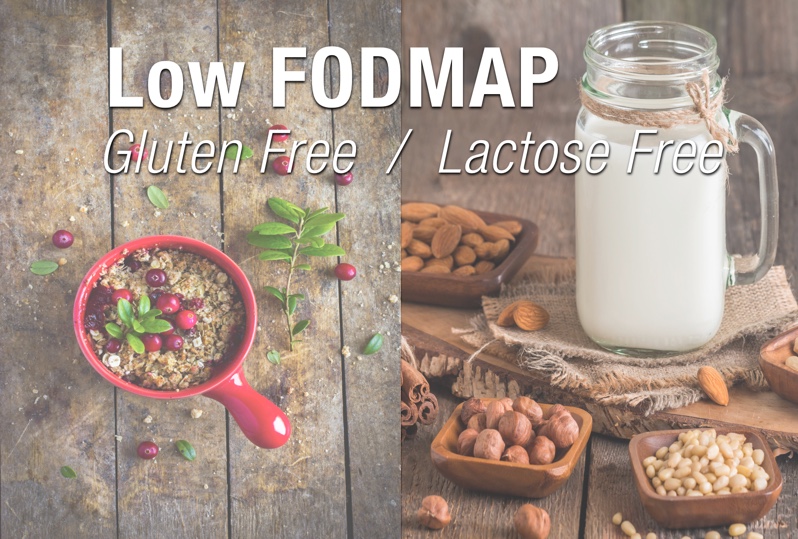Certain foods can cause irritation, whether it be in the stomach, small or large intestines. End result is digestive discomfort which can be mild to severe, even leading to significant health problems. There are many ‘diets’ currently recommended and before undertaking any elimination-type diets you should consult a qualified health professional in order to avoid creating more problems. Here is some information on the low FODMAP diet which, like all elimination diets, should not be followed for long periods of time.
FODMAP is an acronym for Fermentable Oligosaccharides Disaccharides Monosaccharides and Polyols. These are sugar compounds and sugar alcohols, which are commonly found in the foods that we eat, and can be problematic for some people, causing digestive discomfort.
The Low FODMAP Diet was developed by a team of researchers at Monash University in Melbourne, led by Peter Gibson. They provided the initial evidence that a low FODMAP diet was beneficial in improving symptoms of Irritable Bowel Syndrome (IBS).
What are FODMAPS?
In the table below, the various compounds are outlined, they are fermentable:
| Oligosaccharides | Disaccharides | Monosaccharides | Polyols |
|
|
|
|
FODMAPs are commonly occurring in a wide range of fruits, vegetables, specific
FODMAPs and The Digestive System

FODMAPs are sugar compounds which are poorly absorbed in the small intestine. They are made up of two or more sugar molecules that need to be broken down into individual sugar units (monosaccharides) to be absorbed across the intestinal epithelium.
FODMAPs are generally poorly absorbed in the human gastrointestinal tract:
- Oligosaccharides (fructans and galactans): Humans have naturally low levels of hydrolases making it difficult to cleave these carbohydrates.
- Disaccharides (lactose): Lactose is poorly cleaved by the hydrolase lactase, into monosaccharides (galactose and glucose), as lactase has low activity in the brush border of the small intestine.
- Monosaccharides (fructose): Fructose is absorbed via transporters which have a very low capacity (GLUT5 transporters) for facilitated diffusion across the intestinal lumen.
- Polyols: These molecules are too large for passive diffusion.
FODMAPs are osmotic and attract water as they remain in the intestinal lumen. Malabsorbed FODMAPs molecules will remain in the distal small intestine and proximal large intestine. The water may cause distension and bloating, discomfort, and altered bowel movements.
FODMAPs are fermented in the large intestine by intestinal microflora. Monosacchardies, disaccharides, and oligosaccharides become fermented rapidly by commensal and dysbiotic intestinal bacteria. As fermentation occurs, gases such as hydrogen, methane and carbon dioxide are produced; and in some individuals this produces symptoms of gastrointestinal discomfort.
FODMAPs and Irritable Bowel Syndrome
Irritable Bowel Syndrome is a very common functional gastrointestinal disorder. It is characterized by symptoms of gastrointestinal pain, cramping, bloating, flatulence, and altered bowel habits such as diarrhoea and/or constipation. The underlying causes of IBS vary in different people, and are not very clearly understood, however altering your diet plays a major role in the symptom management of IBS.
People with sensitive digestive systems experience IBS symptoms due to the expansion of the gut by gas and/or water. This process can exacerbate symptoms of IBS. Although FODMAPs are not the cause of IBS, a low FODMAPs diet can significantly improve IBS symptoms.
Foods which contain FODMAPs are very normal, healthy foods and do not cause symptoms in most people. However, if you are susceptible to gastrointestinal disorders, there may be an increased response to the activation of the enteric nervous system due to intestinal lumen distension; in turn causing heightened symptoms.
Benefits of the low FODMAP Diet
Digestive support, through the elimination of high FODMAP foods, conditions such Irritable Bowel Syndrome (IBS), dyspepsia, and reflux may be ameliorated.
Neurological support, as there is some preliminary evidence that a low FODMAP diet may play a role in mood and neurological disorders. Both fructose and lactose malabsorption have been linked with mild depression, and a low fructose diet has been found to improve symptoms of low moods. A study demonstrated that people with fructose malabsorption had higher depression scores, and lower levels of plasma tryptophan, the precursor of the “happy/feel good” neurotransmitter serotonin. Therefore, high fructose concentrations in the gastrointestinal tract may synthesize large amounts of fructose-L tryptophan complexes, in turn reducing tryptophan absorption.
Traits of a low FODMAP diet
It is favorable to reduce all types of FODMAPs in the diet simultaneously in order to assess the benefits of the diet in an individual.
Foods containing FODMAPs have benefits, as they are nutritionally dense, and they provide fiber and prebiotics, contributing towards good gut health. It is not recommended to follow a low FODMAP diet for life. Strict adherence to the protocol under the guidance of a qualified practitioner is recommended. An elimination phase, followed by a challenge/reintroduction phase is common practice.
After eliminating high FODMAPs foods, there is a systematic reintroduction of specific foods, one by one in order to observe tolerance and any reactions.
FODMAPS elimination phase
During the elimination phase, you should exclude high FODMAP foods for at least six weeks. During this time a good quality probiotic, potentially alongside other gut healing nutrients and/or herbal medicines may be prescribed. If there is no improvement of symptoms during this time, it is highly recommended to investigate for other causes of gastrointestinal discomfort.
FODMAPS reintroduction phase
 During the reintroduction phase, each FODMAP is consumed slowly to gauge your tolerance and the amount of FODMAPs that can be eaten comfortably without provoking symptoms. If symptoms arise during the reintroduction phase, they should resolve first before a new food is reintroduced. Apart from the FODMAP food that is being challenged, all other FODMAPs are to be avoided during the challenge/reintroduction phase.
During the reintroduction phase, each FODMAP is consumed slowly to gauge your tolerance and the amount of FODMAPs that can be eaten comfortably without provoking symptoms. If symptoms arise during the reintroduction phase, they should resolve first before a new food is reintroduced. Apart from the FODMAP food that is being challenged, all other FODMAPs are to be avoided during the challenge/reintroduction phase.
The well-tolerated FODMAPs are then consumed to determine the tolerance of the combination of foods. If symptoms resume, then the FODMAPs are removed until the symptoms resolve. They are then reintroduced at a lower dose.
If during the reintroduction phase specific FODMAPs are still causing issues, then it is recommended to completely avoid or significantly restrict these foods.
What can be eaten and what is excluded with Low FODMAP?
Certain foods should only be avoided above a certain amount, as some FODMAPs foods can be tolerated in lesser amounts. These are outlined in the table below.
Eliminate the following food groups:
| High Lactose foods | Milk (cow, goat, sheep) Cheese
Ice Cream Custard |
| High Oligosaccharide foods | ChickpeasLentils |
| High Fructose foods | Some fruits (cherries >3, apples, pears, peaches, mango, watermelon)Honey >5g daily |
| High Fructan foods | Some fruits (nectarines, peaches, persimmons, watermelon)Some vegetables (garlic, onion, leek, spring onion, cabbage >1 cup, artichokes, asparagus>3) |
| High Polyol foods | Some fruits (apples, apricots, avocados >1/4, pears, peaches)Some vegetables (cauliflower, celery>1 stick, mushrooms)
|
Foods that can be consumed on a low FODMAP diet
| Lactose foods | Lactose-free dairy products. Some cheeses (Brie, camembert, cheddar, feta, mozzarella, Swiss, parmesan) |
| Fructose foods | Bananas, blueberries, rock melon, coconut, kiwi, lemon, lime, passionfruit, pineapple, raspberries, strawberries (1 serving max per meal)
Maple syrup |
| Oligosaccharide/fructan foods | Bok choy, bean sprouts, rocket, capsicum, lettuce, carrots, chives, cabbage, cucumber, green beans, eggplant, kale, tomatoes, potato, radish, spinach, chard, green part of spring onions, zucchini. Some gluten free breads
Corn, rice, quinoa Nuts and seeds (almonds, macadamia, pine nuts, pumpkin seeds, sesame seeds, chia seeds, flax seeds) Tempeh, firm tofu |
| Polyols | Avocado if less than ¼, Celery 1 stalk, cherries if less than 3, lychee if less than 5, sweet potato if less than ½ cup. |
| Protein/Meat | Meat Poultry
Eggs |
| Beverages | Espresso, black tea, white tea, green tea, peppermint and other herbal teas. Most wine, beer, vodka and gin. Limit to 1 drink.
|
One day on the Low FODMAP Diet:
Below are examples of meals that you could eat on the low FODMAP diet:
Breakfast |
Lunch |
Dinner |
Snacks |
|
|
|
|
References:
Ireton-Jones C, 2017, ‘The low FODMAP diet: fundamental therapy in the management of irritable bowel syndrome’, Curr Opin Nutr Metab Care,
Ledochowski M, Widner B, Sperner-Unterwerger B, Propst T, Vogel W, Fuchs D, 2000, ‘Carbohydrate malabsorption syndromes and early signs of mental depression in females’, Dig Dis Sci, 45: 1255–9.
Ledochowski M, Widner B, Bair H, Probst T, Fuchs D, 2000, ‘Fructose- and sorbitol-reduced diet improves mood and gastrointestinal disturbances in fructose malabsorbers’, Scand J Gastroenterol, 35: 1048–52.
Nanayakkara WS, Skidmore PM, O’Brien L, Wilkinson TJ, Gearry RB, 2016, ‘Efficacy of the low FODMAP diet for treating irritable bowel syndrome: the evidence to date’, Clin Exp Gastroenterol, 9:131-132
